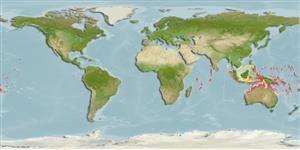Environment: milieu / climate zone / depth range / distribution range
Οικολογία
Θαλασσινό(ά) Υφαλόφιλο(α); εύρος βάθους 0 - 30 m (Ref. 9710). Tropical; 12°N - 24°S, 55°E - 154°W (Ref. 5222)
Indo-West-Pacific: East coast of Africa to the Line Islands. Except for its occurrence along the African coast (Zanzibar, Tanzania to Ponta Zavora, Mozambique) it seems to be primarily an insular species, occurring at most (probably all) of the islands of tropical Indian and west-central Pacific. Not known from the Red Sea, Persian Gulf, Sri Lanka, Philippines, Taiwan, Japan, or Australian waters (however, it is found at Rowley Shoals off Western Australia).
Length at first maturity / Μέγεθος / Βάρος / Age
Maturity: Lm ?, range 19 - ? cm
Max length : 47.5 cm TL αρσενικό/απροσδιόριστο; (Ref. 125599); μεγ. δημοσιευμένο βάρος: 1.5 kg (Ref. 125599)
Ραχιαίες άκανθες (συνολικά): 11; Μαλακές ραχιαίες ακτίνες (συνολικά): 14-16; Εδρικές άκανθες 3; Μαλακές εδρικές ακτίνες: 8. Preopercle rounded, with a shallow notch; the serrae are enlarged but covered with skin; upper edge of the operculum almost straight. The head and body mostly covered with close-set dark brown, olive, or reddish brown spots. Those on the dorsolateral parts of the head, body, and on median fins polygonal and close-set, with the interspaces forming a white reticulum. Those on the ventral portions are more rounded, more separated and often more reddish. Three dark blotches are often visible at the base of the dorsal fin and one forming a saddle blotch on the caudal peduncle. These blotches differentiates it from E. merra and E. quoyanus (Ref. 5222). Small conspicuous dark spots on snout and sometimes between or below the eyes (Ref. 37816).
Occurs in lagoon patch reefs, the upper slopes of channels, and reef margins (Ref. 1602). Carnivorous (Ref. 81697). Nothing has been published on its biology. Solitary (Ref 90102).
Life cycle and mating behavior
Γεννητική Ωρίμανση | Αναπαραγωγή | Γεννοβολία | Αβγά | Γονιμότητα | Προνύμφες
Heemstra, P.C. and J.E. Randall, 1993. FAO Species Catalogue. Vol. 16. Groupers of the world (family Serranidae, subfamily Epinephelinae). An annotated and illustrated catalogue of the grouper, rockcod, hind, coral grouper and lyretail species known to date. Rome: FAO. FAO Fish. Synop. 125(16):382 p. (Ref. 5222)
IUCN Red List Status (Ref. 130435)
Threat to humans
Harmless
Human uses
αλιεία: Εμπορικό(ά); αλιεία αναψυχής: ναί
Περισσότερες πληροφορίες
ΑναφορέςΥδατοκαλλιέργειεςΠροφίλ υδατοκαλλιέργειαςΣτελέχοιΓενετικήElectrophoresesΚληρονομικότηταΑσθένειεςΜεταποίησηNutrientsMass conversion
ΣυνεργάτεςΦωτογραφίεςStamps, Coins Misc.ΉχοιΣιγκουατέραΤαχύτηταΚολυμβητικός ΤύποςΕπιφάνεια βραγχίωνOtolithsΕγκέφαλοιΌραση
Εργαλεία
Special reports
Download XML
Διαδικτυακές πηγές
Estimates based on models
Preferred temperature (Ref.
123201): 26.1 - 29.3, mean 28.6 °C (based on 1392 cells).
Phylogenetic diversity index (Ref.
82804): PD
50 = 0.5000 [Uniqueness, from 0.5 = low to 2.0 = high].
Bayesian length-weight: a=0.01122 (0.00699 - 0.01802), b=3.06 (2.93 - 3.19), in cm total length, based on LWR estimates for this species & Genus-body shape (Ref.
93245).
Τροφικό Επίπεδο (Ref.
69278): 3.8 ±0.5 se; based on size and trophs of closest relatives
Ελαστικότητα (Ref.
120179): Μεσαίο(α), ελάχιστος χρόνος για διπλασιασμό πληθυσμού 1,4 - 4,4 έτη (Preliminary K or Fecundity.).
Fishing Vulnerability (Ref.
59153): Moderate vulnerability (38 of 100).
Nutrients (Ref.
124155): Calcium = 37.5 [18.0, 76.4] mg/100g; Iron = 0.528 [0.290, 1.094] mg/100g; Protein = 18.5 [17.0, 19.9] %; Omega3 = 0.123 [0.077, 0.196] g/100g; Selenium = 27.3 [16.0, 48.5] μg/100g; VitaminA = 228 [63, 825] μg/100g; Zinc = 1.45 [0.99, 2.03] mg/100g (wet weight); based on
nutrient studies.
